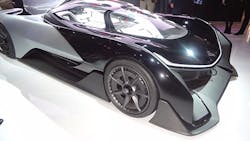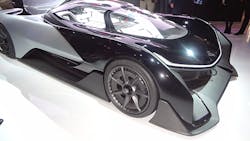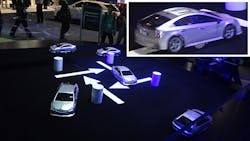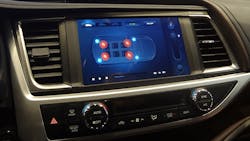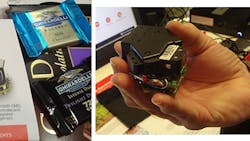For Day 3 at the Consumer Electronics Show (CES), I concentrated on the North and some of the backroom meetings. The North hall holds most of the automotive tech, while the hotel suites and ballrooms are where most of the technology companies show off their wares.
Much of the technology on display was forward-looking, some of it more “forward” than others. Faraday Future’s FFZERO1 electric concept car (Fig. 1) had a lot of buzz, but was more of a shell than an operational prototype.
The Faraday Future was not the only forward-looking display at CES, though. Toyota said it will invest $1 billion in the Toyota Research Institute, which will focus on studying artificial intelligence to help lead to safer and more advanced vehicles. It will initially have laboratories near Stanford University and M.I.T.
The Toyota demo (Fig. 2) had multiple, self-driving vehicles that used distributed, shared, machine-learning techniques. The cars communicated with each other wirelessly, providing learned information to each other.
A closer look at the cars reveals a two-wheel robot with a car-like body. The four wheels on the body do not move. This allows the cars to turn more sharply and greatly simplifies the models; however, that shouldn’t detract from the complexity of the demo.
QNX was showing its latest advanced automotive platform. QNX systems are already found inside many high-end automotive solutions today, but this platform targets advanced driver-assistance systems (ADAS) and self-driving cars. The company also unveiled some audio technology that will likely find its way into automobiles sooner than the platform. The technology coordinates multiple microphones and speakers spaced around the interior of a car as highlighted by an on-screen representation (Fig. 3).
QNX’s audio technology allows a driver to hear a speaker in the back of the vehicle even in a very noisy environment. It works in the other direction as well, so no one has to turn their head around or shout to be heard. It was quite an impressive demo that’s not easily replicated with photos. This combination of noise cancellation and speaker management also might be showing up a lot sooner than a self-driving car.
Some of the behind-the-scenes meetings were as interesting as the technology on the floor. One neat gadget you can get now comes from Texas Instruments. The DLP NIRscan Nano module (Fig. 4) is a compact, handheld spectrometer. It uses DLP technology to focus the light reflected off a sample to a single, low-cost sensor, offering a cost-effective alternative to the more complicated InGaAs linear array-based detector designs found on larger, more expensive devices.
In the demo, the $999 module (the DLP NIRscan is $8499) was used to detect the type of chocolate placed on the sensor—the determining factor was the sugar content. Of course, the spectrometer can detect much more than sugar content. The system is optimized for a 900- to 1700-nm wavelength range, features an impressive 6,000:1 signal-to-noise ratio. The module, based on a DLPC150 DMD controller and Tiva TM4C1297NCZAD processor, can operate off batteries.
About the Author
William Wong Blog
Senior Content Director
Bill's latest articles are listed on this author page, William G. Wong.
Bill Wong covers Digital, Embedded, Systems and Software topics at Electronic Design. He writes a number of columns, including Lab Bench and alt.embedded, plus Bill's Workbench hands-on column. Bill is a Georgia Tech alumni with a B.S in Electrical Engineering and a master's degree in computer science for Rutgers, The State University of New Jersey.
He has written a dozen books and was the first Director of PC Labs at PC Magazine. He has worked in the computer and publication industry for almost 40 years and has been with Electronic Design since 2000. He helps run the Mercer Science and Engineering Fair in Mercer County, NJ.
- Check out more articles by Bill Wong on Electronic Design
- Bill Wong on Facebook
- @AltEmbedded on Twitter
